
Shearing shed design - the board
Introduction
The shearing board is that area where sheep are shorn and let out of the shearing shed. Conventional sheds have the pen area, shearing board and wool room built on the same level, but raised shearing boards have become popular in recent years. A raised board minimises interference between shearers and shed workers by giving the shearers their own work area above the wool room floor. It also lets the shed workers pick up each fleece without bending, saving time and reducing fatigue. The cost of a raised shearing board, catching pens and sheep holding area is usually slightly more than the cost of a conventional shearing shed.
Board design
Traditionally shearing sheds have been built around two main board designs: centre-board and across-the-board.
Centre-board
In a centre-board shed the shearer catches a sheep from a pen behind the shearing stand and drags the sheep out onto the board. When the sheep is shorn it is let out beside the catching pen via a race or chute.
The centre-board design benefits both shearers and shed workers. The distance the shearer drags the sheep is reduced and there is little interference between shearers and shed worker. The distance fleeces need to be carried for skirting can also be reduced. The design can incorporate a conventional or raised board and suits a range of board layouts.
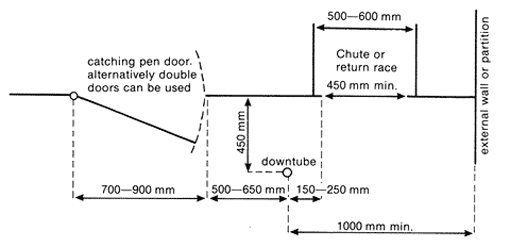
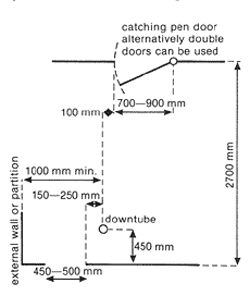
Across-the-board
In an across-the-board shed the shearer catches a sheep from a pen opposite the shearing stand and drags the sheep ‘across-the-board’ to the shearing position. When the sheep is shorn it is let out behind the stand, leaving the board on the opposite side to the catching pen.
The congestion caused by shearers, shed workers, sheep and wool continually crossing paths is a major fault of this design.
Raised shearing board
A raised board simplifies the work of the shed workers as well as reducing interference between sheep, wool, shearers and shed workers. It also makes removal of stained wool easier during shearing. A raised board should be between 750 mm and 850 mm above the wool room floor, and 1830 mm wide at the stands. This width and height combines shearer safety with increased working ease for workers picking up fleeces.

No brooms are needed to sweep a raised board: a 150 mm × 12 mm piece of light timber about 900 mm long is used to clear the board of locks. The area under the board can be used for storing locks.
A raised board can be built in either a straight line or curved design. It is also suited to ‘U’ or ‘L’ shaped designs.
In some raised-board shearing sheds the wool room is at ground level. This has the disadvantages that under-floor sheep storage is lost and bales have to be lifted for loading onto trucks. On the other hand, a ground level wool room (usually with a concrete floor) can be used as a machinery parking area or to store bulk fertiliser, seed or grain at harvest time. These practices have to be reviewed when quality assurance or shed tidy schemes are used.
Resolution of this problem is a matter for the individual woolgrower. It may be governed largely by factors such as other farm enterprises, condition and size of farm sheds and availability of a 3-point linkage jib or front-end loader for lifting bales. It may involve construction of a skillion for additional sheep storage.
Another approach is to select a sloping site on which to build the shearing shed. Sheep can enter at ground level at one end of the shed and bales can be loaded at truck height at the other. Sheep holding pens can then be built under the wool room.
Curved shearing board
A curved board can be built as a conventional level board, or as a raised shearing board. By curving or bending the board the installation of front-fill catching pens is simplified. Another advantage is the reduced walking distance for shed workers carrying shorn fleeces from the board to the wool table or press.
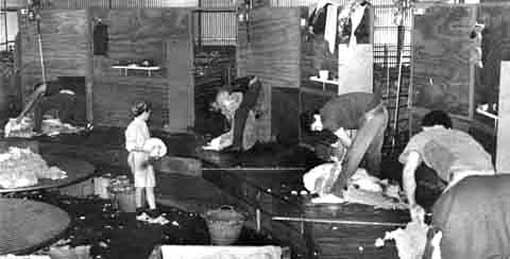
The curved board is a departure from the conventional arrangement of having the shearing stands in a straight line. Individual electric shearing units allow alternative board configurations where the stands can be set at any angle up to 90° to each other. The curved board is recommended for most efficient use of front-fill catching pens.
A curved-board design requires greater width than the equivalent straight-board layout. Installation of a curved board generally costs more than a straight board because of the larger shed and roof area, as well as extra time and skill required to set out the piers, bearers and joists.
The shearing stand
Dimensions
Several dimensions are important when setting up a shearing stand to ensure favourable working conditions for shearers. The position of the downtube in relation to the catching pen and let-go entrance is shown in Figure 1. The large dimensions apply for big-framed sheep.
Shearing units
Where electric power is available at the shearing shed, independent electric shearing units are now more popular than a shaft-driven shearing plant. Individual electric units have an advantage during crutching since only one or two units need to be run rather than the whole plant. Individual electric units are quieter and usually need less maintenance than line-shaft machinery. Electric units can be attached to a 150 mm × 100 mm head plank (preferably Oregon) or an independent post for each stand. Consult the maker’s specifications before installation.
The downtube must hang 420 to 450 mm away from the wall. If it is closer than this the elbow joint will knock against the wall and restrict the shearer. The bottom end of the downtube should describe a 200 mm diameter circle on the floor when the plant is correctly installed. This means that the downtube should be lowered about 13 mm from the point where it would just touch the floor. The downtube must also be at least 1000 mm and preferably 1200 mm from the nearest side wall.
Shearer’s equipment
A shearer’s oilcan, screwdriver and comb brush should be provided with each handpiece. At each stand there should be a shelf or recessed box for shearing equipment and personal items.
Double-end disc grinders are better than single units. Make sure there is plenty of light so that combs and cutters can be sharpened properly. Locate the grinder in a safe place away from normal working areas.
Distance between stands
The minimum distance between shearing stands allowed under the Pastoral Industry Award 1954 is 1524 mm, but this is too close for efficient working conditions. If possible, allow at least 1800 mm between stands. This reduces the risk of interference between adjacent shearers. In centre-board design sheds, the distance between stands is determined mainly by the width of the catching pen. Check this aspect before setting final shearing-board dimensions.
Flooring
19 mm thick tongue-and-groove pine flooring is satisfactory material for the shearing board. Several widths of flooring timbers are available commercially. It is important that tongue-and-groove flooring be tightly cramped with builder’s floor cramps when it is installed. Alternatively, you can use 18 mm particle board with 6.3 mm masonite covering for the board.
The shearing board flooring can be either treated with linseed oil or painted with tung oil. A painted surface prevents grease build-up on the floor and makes sweeping easier, but can be slippery for shearers.
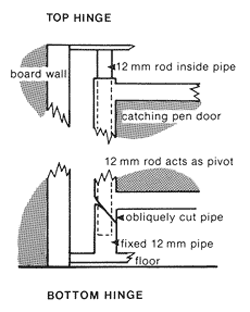
Partition between the board and sheep pens
The partition between the board and the sheep pens should be at least 1.5 m high (see Figure 3 and Figure 4). This prevents sheep from seeing movement on the board, making penning-up easier. Wooden partitions between the board and pen area are less noisy than metal.
Self-centring hinges (see Figure 5) are preferable to the double-action type on catching-pen doors because of their more rugged construction and longer life. These hinges close the doors quickly, and will keep them closed while sheep are moving into the catching pen. The hinges are made with two pieces of 12 mm pipe (internal diameter), cut at an oblique angle.
Let-go systems
The aim of any let-go system is to get the shorn sheep away from the shearing board quickly and easily. Most systems hold the sheep from each shearing stand separate until they are counted out. Where automatic sheep counters are installed the sheep usually move directly into a holding yard or paddock after being shorn. The positioning and minimum dimensions for the let-go entrance are set out in Figure 6.
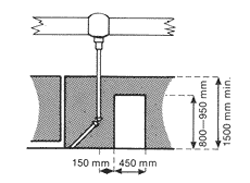
There are four systems in use for releasing shorn sheep from the shearing shed. Chutes, tipping chutes and return races are used in centre-board design sheds and external portholes are used in across-the-board shearing sheds.
Chutes
Chutes can be constructed from either timber products or galvanised sheet steel. Sheep are let out underneath the shed via a sliding chute, where the shearing board is built at least 1 m off the ground. In high-clearance or raised-board sheds, double-angle outlet chutes may be needed to slow the rate of fall of sheep.
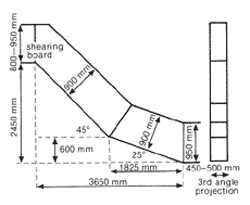
If the chute opening is recessed forward into the shearing board by 150 mm, with a drop of 100 mm, the sheep can be more easily released. To achieve this the chute is attached to the bottom of a flooring joist which must coincide with the edge of the recessed opening.
Tipping chutes
Another sheep let-out system is the tipping chute. This reduces cold draughts on the board because the tipping platform virtually closes off the chute opening. The tipping chute consists of a horizontal counterbalanced platform which must be pivoted at the shearing-board end. As the sheep walks along the platform its weight causes the platform to swing downwards releasing the sheep.
The tipping platform is 2000 mm to 3000 mm long by 500 mm wide. Use damping mechanisms to control the movement of the tipping platform. The surface of the tipping platform must be smooth so that the sheep will slide. Counterweights return the platform to the horizontal position, ready for the next sheep. Below the grating, the walls of the chute should be enclosed to prevent injury to the sheep. At crutching, the tipping platform can be locked in the ‘down’ position, and used as a conventional chute. Alternatively, it may be locked in the horizontal position for returning sheep back onto the grating through a small gate.
Return races
In some areas, particularly in cooler climates, internal races are popular. Draughts are less likely to be a problem to shearers where return races are installed. A race running across the shed behind the filling pens and exit doors must be planned carefully so that the flow of woolly sheep in the pen area is not hindered.
Shorn sheep are let into a return race on the grating. They can be held in the return race for further husbandry operations (such as drenching), unaffected by the weather.
External portholes
This system is used in across-the-board design shearing sheds. Shorn or crutched sheep are let directly out of the shed through portholes in the outside wall. It is a simple let-go system but exposes shearers to draughts. Counting-out pens are essential when external portholes are used to let sheep out of the shed.
Counting-out systems
It is essential that an accurate count is made of the number of sheep shorn or crutched. Traditionally, counting-out pens have been used to hold sheep until they can be counted. Counting-out pens should be large enough to hold all sheep shorn by a shearer in each run—40 or more sheep. Allow three to four shorn sheep per square metre when calculating counting-out-pen areas. Larger pens (holding about 60 sheep) are an advantage at crutching time. If these pens are outside the shed it is advisable to make the fences about 900 mm high to prevent shorn sheep jumping out.
Mechanical and electronic counting devices have been developed for automatic counting-out systems. The installation of counters saves time in counting out, can eliminate the need for individual counting-out pens, and allows sheep to be returned directly to pasture or to the yards for further treatment.
The success of these automatic counting devices has varied. Most mechanical counters have been unreliable or susceptible to damage. Electronic devices with digital display on the board wall offer the best method of automatically counting out sheep as they are shorn or crutched, and can be used in chutes or return races. It is recommended that mechanical or electronic counting devices be installed only after consultation with the shearers or contractor.
Further information
For further information on shearing shed design, see the following publications:
- Shearing shed design—sheep storage and movement (Agfact A3.E.1)
- Shearing shed design—the wool room (Agfact A3.E.3)
- Shearing shed design—lighting and ventilation (Agfact A3.E.4)
Acknowledgment
This Agfact was adapted in part from the Australian Wool Corporation publication Wool Harvesting Notes.

